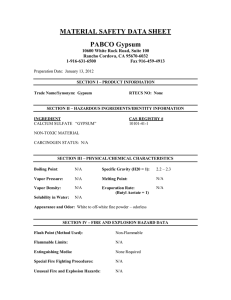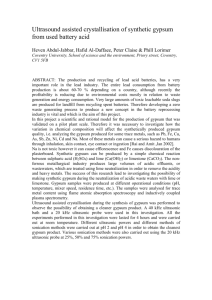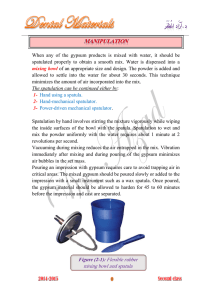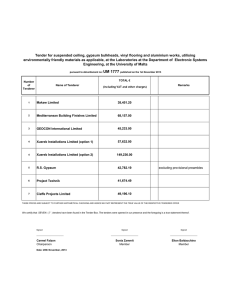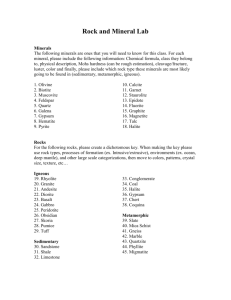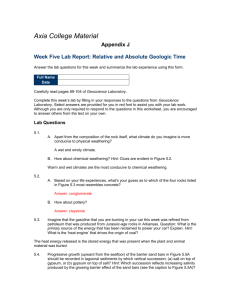Research Journal of Applied Sciences, Engineering and Technology 12(1): 86-93,... DOI:10.19026/rjaset.12.2306
advertisement
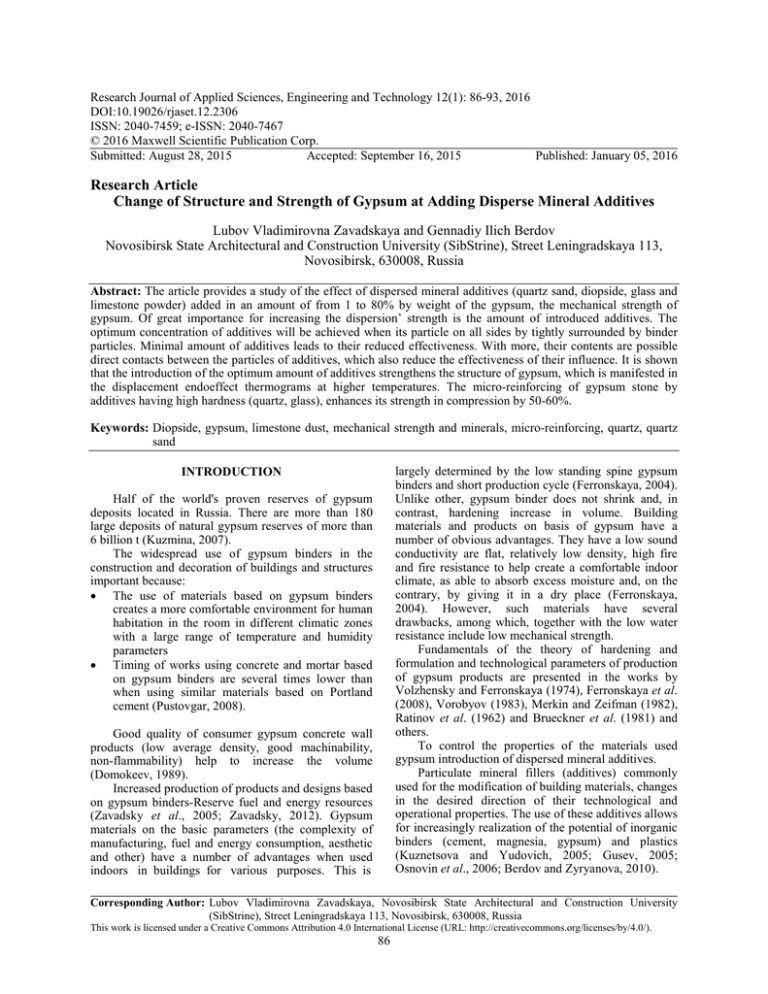
Research Journal of Applied Sciences, Engineering and Technology 12(1): 86-93, 2016 DOI:10.19026/rjaset.12.2306 ISSN: 2040-7459; e-ISSN: 2040-7467 © 2016 Maxwell Scientific Publication Corp. Submitted: August 28, 2015 Accepted: September 16, 2015 Published: January 05, 2016 Research Article Change of Structure and Strength of Gypsum at Adding Disperse Mineral Additives Lubov Vladimirovna Zavadskaya and Gennadiy Ilich Berdov Novosibirsk State Architectural and Construction University (SibStrine), Street Leningradskaya 113, Novosibirsk, 630008, Russia Abstract: The article provides a study of the effect of dispersed mineral additives (quartz sand, diopside, glass and limestone powder) added in an amount of from 1 to 80% by weight of the gypsum, the mechanical strength of gypsum. Of great importance for increasing the dispersion’ strength is the amount of introduced additives. The optimum concentration of additives will be achieved when its particle on all sides by tightly surrounded by binder particles. Minimal amount of additives leads to their reduced effectiveness. With more, their contents are possible direct contacts between the particles of additives, which also reduce the effectiveness of their influence. It is shown that the introduction of the optimum amount of additives strengthens the structure of gypsum, which is manifested in the displacement endoeffect thermograms at higher temperatures. The micro-reinforcing of gypsum stone by additives having high hardness (quartz, glass), enhances its strength in compression by 50-60%. Keywords: Diopside, gypsum, limestone dust, mechanical strength and minerals, micro-reinforcing, quartz, quartz sand largely determined by the low standing spine gypsum binders and short production cycle (Ferronskaya, 2004). Unlike other, gypsum binder does not shrink and, in contrast, hardening increase in volume. Building materials and products on basis of gypsum have a number of obvious advantages. They have a low sound conductivity are flat, relatively low density, high fire and fire resistance to help create a comfortable indoor climate, as able to absorb excess moisture and, on the contrary, by giving it in a dry place (Ferronskaya, 2004). However, such materials have several drawbacks, among which, together with the low water resistance include low mechanical strength. Fundamentals of the theory of hardening and formulation and technological parameters of production of gypsum products are presented in the works by Volzhensky and Ferronskaya (1974), Ferronskaya et al. (2008), Vorobyov (1983), Merkin and Zeifman (1982), Ratinov et al. (1962) and Brueckner et al. (1981) and others. To control the properties of the materials used gypsum introduction of dispersed mineral additives. Particulate mineral fillers (additives) commonly used for the modification of building materials, changes in the desired direction of their technological and operational properties. The use of these additives allows for increasingly realization of the potential of inorganic binders (cement, magnesia, gypsum) and plastics (Kuznetsova and Yudovich, 2005; Gusev, 2005; Osnovin et al., 2006; Berdov and Zyryanova, 2010). INTRODUCTION Half of the world's proven reserves of gypsum deposits located in Russia. There are more than 180 large deposits of natural gypsum reserves of more than 6 billion t (Kuzmina, 2007). The widespread use of gypsum binders in the construction and decoration of buildings and structures important because: • The use of materials based on gypsum binders creates a more comfortable environment for human habitation in the room in different climatic zones with a large range of temperature and humidity parameters • Timing of works using concrete and mortar based on gypsum binders are several times lower than when using similar materials based on Portland cement (Pustovgar, 2008). Good quality of consumer gypsum concrete wall products (low average density, good machinability, non-flammability) help to increase the volume (Domokeev, 1989). Increased production of products and designs based on gypsum binders-Reserve fuel and energy resources (Zavadsky et al., 2005; Zavadsky, 2012). Gypsum materials on the basic parameters (the complexity of manufacturing, fuel and energy consumption, aesthetic and other) have a number of advantages when used indoors in buildings for various purposes. This is Corresponding Author: Lubov Vladimirovna Zavadskaya, Novosibirsk State Architectural and Construction University (SibStrine), Street Leningradskaya 113, Novosibirsk, 630008, Russia This work is licensed under a Creative Commons Attribution 4.0 International License (URL: http://creativecommons.org/licenses/by/4.0/). 86 Res. J. Appl. Sci. Eng. Technol., 12(1): 86-93, 2016 n In many cases, the introduction of additives provides a cost reduction of expensive binders. It should be noted that the amount of mineral additives introduced in many cases arbitrarily selected and varied from fractions of a percent to several tens percent by weight of the binder substance. Dispersibility of these additives are not always taken into account and in some cases not disclosed in the publications. Quite often used as additives production waste for saving and dispose of binders. To increase the strength of gypsum can be used the micro-fibres (polyamide, basalt) (Chernysheva and Rybakova, 2009) or dispersed mineral additives (wollastonite, diopside, limestone). A noticeable impact on the strength and deformation properties of the obtained material is manifested at a sufficient saturation of the fibres. Of great importance for increasing the strength of a dispersion and the quantity of the additive. The optimum concentration of additive will be achieved when its particle on all sides by tightly surrounded by binder particles. Minimal amount of additives will reduce their effectiveness. With more, their contents are possible direct contacts between the particles of additives that also reduce their impact effectiveness (Berdov et al., 2012a). Let us consider the effect of the number and dispersion of additives on the properties of gypsum. Interaction of particles with binder additives made in the contact zone of these components. When analysing the effect of additive concentration on the properties of gypsum, assume that as the particle binder and the additives have a spherical shape and the same dimensions, the additive particles are distributed uniformly over the volume. In this case, acceptable patterns of formation of a dense structure with packing of spheres. In structures with dense packing of two possible ways: a Cubic Close Packing (CCP) and a Hexagonal Closest Packing (HCP). In addition, each ball touches the other 12 balls (Kingeri, 1967; Pauling, 1974). In the close-packed structure of balls they hold 74.05% of the total. 25.95% is the void between the balls. Imagine that the central ball is additive particles and 12 surrounding the balls are gypsum particles. This will be achieved the maximum possible contact of the particles with particles of gypsum additives. The volume fraction of the additive, in this case amounts to 1/12 of the volume fraction of the gypsum, i.e., 8.3%. If the density of different additives on density gypsum, the weight fraction of additive may be determined by the ratio of the densities: Д Г = ∙ = 8,3 ρD ρG k = The mass fraction of additive in percent by weight of gypsum = True density additives g/cm3 = True density gypsum g/cm3 = Coordination number If the particle size of the additive is less than cementitious particles, the closest packing of particles is achieved at a lower coordination number, i.e., fewer gypsum particles surrounding the additive particles. If we regard gypsum particles and additives as spherical, it can be estimated to determine the coordination number of the first rule of Pauling (1974). Thus, if the diameter of the additive particles is less than twice the diameter of the particles of gypsum, in accordance with this rule probable coordination number with dense packing of particles is 6, that is, each particle is surrounded by six additives gypsum particles. In this case, the amount of additive particles is 1/48 of the volume of the gypsum. Application of the rules of Pauling (1974) in this case is arbitrary, since it is valid for the case of placing the ions in the crystal lattice. The amount of ions of each species is the same and in addition to the closest packing of the particles requires the payment of electric charges of the ions to provide electrical neutrality of the crystal lattice as a whole. However, quantitative estimation of the influence of dispersion of additives is quite clear: with increasing optimum amount of dispersion decreases. The calculation of the optimum amount of mineral supplements can be made as follows. Let us assume that the gypsum particles and additives have a spherical shape. The diameter of the gypsum particles is D r, D -D additive particles. If the particle diameter of the additive (D E) and gypsum (D T) is significantly different, for calculating the optimum proportion of the additive (n D), the following formula can be used: Д Д = .Д Г · ·Г Д Г = · · Д Г where, k = The coordination number The average particle diameter of the binder and the additive should be determined from the experimental values of the specific surface area, particle size analysis data. The coordination number k can be roughly estimated by the ratio of the diameter of the particles of binder and additives in accordance with the first rule of Pauling (1974) and Berdov et al. (2012b). In the work (Pribytkov, 2013) to reduce the density and increase the strength of gypsum mixtures in their composition serves to introduce the microspheres of glass, glass-ceramic, ceramic, or polymer in an amount Д Г where, 87 Res. J. Appl. Sci. Eng. Technol., 12(1): 86-93, 2016 of 10-60% by weight and along with it up to 30% mineral filler. It is recommended to use lime, marble, dolomite and other carbonate rocks and slaked lime and quicklime. Composition of gypsum mixture (Shchepochkina, 2013) provides reduction of consumption of gypsum. The composition comprises % by weight gypsum of pairs: 24-26, slaked lime 0.1-0.2, silica sand 50, 8-51, 4, sodium chloride, 2, 1-3, water 20-22. The disadvantage of this composition is the low compressive strength of products -3 MPa. The paper (Korovyakov and Ferronskaya, 2010) proposed organo-mineral modifier of gypsum concrete and products. It contains as a main component hydraulic binder (Portland cement, white cement, coloured cement, hydraulic lime). As the active mineral coagulant assembles microsilica used in combination with mineral dispersed on excipients. These excipients may be crushed quartz sand with a surface area of 6500 cm2/g, fly ash, blast furnace slag with a specific surface 4200-4800 cm2/g, glass with a surface area of 9500 cm2/g, the battle ground ceramic waste (claydite electrostatic dust) with a specific surface of 6500 cm2/g. deposit. It contains, by weight % diopside: 70-75; scapolite 10-20; phlogopite -2-3. Chemical composition of the additive,% wt.: 51,0 SiO2; 24,8 CaO; 15,8 MgO; 1,6 Al2O3; 3,6 Fe2О3; LI-0,2. Cullet is crushed fine powder of household glass. Its composition, wt %.: 71-73 SiO2; 13-15 Na2O; 8-10,5 CaO; 1-4 MgO; 0,5-1 Al2O3; 0,1 Fe2О3; 0,1-1 К2О; 0,30,7 SO3. Limestone dust obtained from CJSC "Iskitim limestone quarry" (Novosibirsk region). Its composition, wt %: 54,7 CaO; 0,5 SiO2; 0,5 MgO; 0,2 Al2O3; 0,1 Fe2О3; loss at ignition 40,4. RESEARCH METHODS Laser particle size analysis: Particle size analysis was conducted to obtain information on the size distribution of particles in powders, suspensions and other particulate objects. The result sieve analysis is generally not measured particle size and particle size distribution in the sample. In practice, use of differential and integral is the form of representation of the distribution (Fig. 1). In the first case, the distribution is represented as a diagram, in which the height of the column corresponds to the fraction of particle size fractions, which lies in a range from d to d+∆. In the second case, the RA is a distribution graph in which the X axis is delayed particle size d and the Y axis the proportion of particles of size less than d. The measurement principle is as follows. The laser beam illuminates a cuvette through which the particle suspension is pumped. The scattered radiation is detected particles from different angles using multielement detectors-photodiode array. As measured in this way depending on the intensity of the scattered METHODOLOGY The study used the gypsum brand G-5, satisfying the requirements of GOST 125-79 (1980). Mineral additives introduced in an amount of 1, 3, 5, 7, 9, 20, 40, 60, 80%, respectively by weight of the gypsum. The addition of quartz is crushed quartz sand produced by JSC "Novosibirsk river port" (Novosibirsk region). Diopside-calcium and magnesium silicate (CaO·MgO·2SiO2). Diopside additive is crushed by overburden phlogopite ore production of the Aldan Fig. 1: Differential and integral particle size distribution 88 Res. J. Appl. Sci. Eng. Technol., 12(1): 86-93, 2016 light on the scattering angle calculation is carried out with distribution of particle sizes. Introducing the particle suspension of the researched object (in the form of powder, suspension, or emulsion) in the liquid filled chamber of a centrifugal pump, where under the effect of ultrasound is performed thorough mixing. Passed through the cell suspension re-enters into the pump chamber. During the measurement, all particles repeatedly pass through the beam. The main advantages of the method: • • • • operation of these devices is generally the same. If two samples are heated simultaneously, one of which (subject) changes occur and in the other (standard) there is no change, then the heat flux and hence the temperature of the samples will be different. The difference in the temperatures in the sample and the reference intensity characterizes the process and the temperature at which there is an extreme difference indicates conditions of the process. Shredded additives were introduced into a dry mixture of gypsum and properly mixed. After mixing with water and mixing the mass was poured into forms. The samples were then dried at 80°C for ca 24 h. We studied the compositions were determined by conventional means: the average density, compressive strength and bending. Samples have the size of 4*4*16 cm. Wide measurement range-from fractions of a micron to hundreds of microns High performance-a single measurement is performed for about one minute High reproducibility-provides multiple averaging the results for a large number of particles Suitable for many applications, the presentation of results of analysis-as a function weight (volumetric) fraction of particles by size, defined as the diameter of the equivalent sphere. RESULTS The results are shown in Table 1 to 5. Each of the quantities mentioned therein is the average of at least six experimental results. The table also indicates water and gypsum ratio (W/G). Gypsum samples without additive have the following properties: the average density-1.02 g/cm3, compressive strength -6.48 MPa, the bending strength of -4.1 MPa. Integrated thermal analysis: Differential Thermal Analysis (DTA) is based on determining the temperature at which the heated sample undergoing any conversion (physical or chemical), accompanied by the thermal effect (the emission or absorption of heat). There are many different devices for DTA differing welding unit, registering at elections, etc. However, Table 1: Indicators of dispersion of mineral additives on the results of laser particle size analysis Indicators Silica sand Cullet Average particle size, microns 9.1 8.9 Specific surface cm2/g 6840 6830 The volume fraction of Less than 4 microns 32.7 31.6 particles (%) with size Less than 16 microns 64.3 66.7 Less than 32 microns 84.3 89.8 Diopside 6.1 7520 41.7 65.3 91.6 Table 2: Influence of additives on the properties of diopside gypsum samples Contents diopside wt.%, by weight of gypsum The average density, g/cm 3 1 1.07 3 1.12 5 1.11 7 1.11 9 1.25 20 1.2 40 1.14 60 1.21 80 1.26 Bending strength, MPa 3.96 4.42 4.04 3.97 4.22 3.96 2.94 2.71 2.56 Table 3: Influence of additives on the properties of quartz sand gypsum samples The content of quartz sand, wt.%, by weight of gypsum The average density, g/cm 3 1 1.1 3 1.16 5 1.16 7 1.18 9 1.20 20 1.23 40 1.23 60 1.3 80 1.32 Compressive strength, MPa 7.44 8.62 8.89 9.13 9.67 10.24 8.49 8.32 6.59 89 Limestone dust 13.7 4010 14.4 54.6 89.1 Compressive strength, MPa 7.44 7.68 7.75 8.8 9.16 7.48 6.88 5.54 5.02 Bending strength, MPa 4.28 4.58 5.09 4.62 4.13 4.59 3.89 3.90 2.97 I/G 0.67 0.67 0.67 0.67 0.6 0.6 0.6 0.56 0.54 I/G 0.67 0.67 0.67 0.6 0.6 0.56 0.54 0.52 0.5 Res. J. Appl. Sci. Eng. Technol., 12(1): 86-93, 2016 Table 4: Influence of cullet additives on the properties of the gypsum samples Contents of cullet, % by Bending strength, MPa weight of gypsum The average density, g/cm 3 1 1.07 9.13 3 1.10 8.94 5 1.04 8.8 7 1.04 8.85 9 1.10 7.47 20 1.16 10.05 40 1.18 7.96 60 1.25 8.12 80 1.31 8.00 Compressive strength, MPa 3.66 3.93 3.96 3.24 4.08 3.92 3.82 3.37 2.90 I/G 0.68 0.68 0.68 0.67 0.67 0.57 0.56 0.50 0.50 Table 5: Influence of additives on the properties of limestone powder gypsum samples The content of limestone dust, % by weight of gypsum Compressive strength, MPa 1 7.11 3 4.94 5 6.32 7 8.20 9 5.50 20 7.73 40 3.66 60 6.14 80 5.64 Bending strength, MPa 2.99 2.99 2.91 3.45 3.00 3.31 2.03 3.05 2.81 I/G 0.67 0.67 0.67 0.67 0.67 0.67 0.56 0.56 0.52 When cullet is added, the maximum compressive strength of samples is achieved when an amount of 20% (Table 4). It increased by 35.5% compared to plain gypsum. Investigation of the composition and process parameters produce gypsum products: Investigation of dispersion of mineral supplements: The fineness of additives investigated using laser analyser type PRO-700 company Seislin Enterprice Co., LTD, Tokyo, provides a certain grain size in the range 1-192 microns to 16 range of values (Table 1). Investigation of the effect of the additive limestone powder at an average density and strength of the gypsum: When introducing limestone dust maximum compressive strength of the samples is achieved when its amount is 7% and 8.2 MPa, an increase of 26.5% compared with plain gypsum (Table 5). With the introduction of the limestone dust bending strength decreases. Investigation of the effect of the additive on the diopside average density and strength of the gypsum: The maximum compressive strength of the samples is achieved when diopside is added in an amount of 9% (Table 2). At the same time, it has increased by 40% compared to plain gypsum. With the introduction of this additive compressive strength of the samples increases more substantial than other bending strength. The ratio of compressive strength to the bending strength of the samples without additives is 1.56, while the introduction of the additive ratio is more than 2.0. The results of thermal analysis of complex samples gypsum mineral fillers: To study the structure of gypsum-containing mineral supplement use complex thermal analysis. Differential thermal analysis was carried out on 60 H derivatograph DTG company Shimadzn, Japan in the temperature range 20-1000°C Its weight was 35 mg, a temperature raising speed of 10 C/min. Registration thermal effects is accurate to one hundredth of a degree. Analysis of samples solidified gypsum no addition (Fig. 2), as well as additives, the content of which corresponds to the maximum strength value obtained in preliminary tests. Derivatogram gypsum without additives shows three endoeffects. Origin at 137.58°C corresponding to the removal of 1.5 mol of water of gypsum structure. It is accompanied by a weight loss of about 60% of the total losses in the range of 20-1000°C. Second endoeffect (at 161.45°C) is significantly weaker. It corresponds to the allocation of the remaining structure of gypsum 0.5 moles of water of hydration. Endoeffect Investigation of the effect of the additive on the quartz sand average density and strength of the gypsum: With the introduction of silica sand maximum compressive strength of the samples is achieved when an amount of 20% (Table 3). However, it is increased by 58% compared with plain composition. Maximum bending strength than samples without additives 24%. Introduction of additives quartz sand, a significant effect on the compressive strength. In this case, the ratio of compressive strength to the bending strength of greater than 2.0. Investigation of the effect of the cullet additive on the average density and strength of the gypsum: 90 Res. J. Appl. Sci. Eng. Technol., 12(1): 86-93, 2016 Fig. 2: Results of complex thermal analysis of gypsum at 725.53°C corresponds to a partial decomposition of calcium sulphate. With the introduction of a specified number of additives in all cases, a shift in temperature of the first, most significant and pronounced the first endoeffect to higher temperatures compared with gypsum stone without additives. This indicates a hardening of gypsum stone structure with the introduction of additives, resulting in a significant increase in its strength. When added to 20% ground silica sand or cullet compressive strength is increased by 60%. The offset of the first endoeffect in this case is 4.0-6.5°C. When added to 9% by weight diopside endoeffects first displacement is 4.79°C, the compressive strength increases by 41%. Sufficiently high temperature offset endoeffects first adding 20% by weight limestone dust (5.9°C). However, increasing the compressive strength in this case is only 19% and bending strength even decreases by 13%. The criteria for determining the activity of microfiller are: High chemical resistance to water in hostile environments; high mechanical strength. With the introduction of the mineral filler energy impact surface will have a major impact on both the contact zone and the binder itself. The energy of the crystal lattice of the mineral filler determines its properties such as mechanical strength, thermal stability, the ability to dissolve in water, as well as interaction with the binder. The criteria to assess the effectiveness of action may be considered microfillers their characteristics such as the energy of the crystal lattice, the standard enthalpy of formation and standard entropy of substance. The energies of the crystal lattice are known not for all binders and possible mineral fillers. Much more data is available on their thermodynamic properties. Typically, their molar values are given. However, they are difficult to compare due to the large differences in molar masses of the substances. Significantly more used for comparing are the specific properties of these substances, i.e., per unit mass. Table 6 presents some thermodynamic properties (standard specific enthalpy of formation, standard specific entropy), as well as the density of matter and their hardness on Mohs scale. The crushed cullet has a hardness significantly greater than gypsum, the hardness of high silica glass exceeds 6 on the Mohs scale. These additives effectively reinforce gypsum and accept the bulk of the external load. This causes strength enhancement for gypsum samples. Additive of lime dust apparently has another role. Hardness of calcite (3) is slightly greater than the hardness of gypsum dihydrate (2). However, the thermodynamic characteristics of these compounds are close to each other, which might result in CaCO3 to DISCUSSION AND CONCLUSION The efficiency of mineral additives is determined by that they: • • • • • Micro-reinforce gypsum stone Determine the redistribution of stresses between the gypsum and particles of additive; It is essential that the modulus of elasticity (and, accordingly, the hardness) of the additive material was higher than that of gypsum Affect the hydration process of hardening gypsum Prevent crack propagation in the material May be substrates for the crystallization of the resulting new hydrate phase. The crushed cullet consists essentially of silicon oxide SiO2. 91 Res. J. Appl. Sci. Eng. Technol., 12(1): 86-93, 2016 Table 6: The thermodynamic and physical properties of substances Specific standard enthalpy of Substance formation-∆Hof, kJ/g CaSO4*0,5H2O 10.84 CaSO4*2H2O 11.74 1518 SiO2 (silica) 12.10 CaCO3 (calcium) Specific standard entropy, So J/(g·K) 0.92 1.13 0.70 0.93 Density, g/cm3 2.7 2.3 2.6 2.7 Mohs hardness 2 7 3 effect hydration of gypsum, the particles may be calcite substrates crystallization CaSO4*2H2O. As a result, the compressive strength increases. Thus, the introduction of the optimal amount of manmade dispersed microfillers such as glass, contributes to the compressive strength of gypsum and decrease water and gypsum mixing ratio. The crushed silica sand has a particle larger than diopside (Table 1). It largely determines the shift of the maximum strength to higher concentrations of additives. Introduction of this additive enhances the strength of samples and lowering water and gypsum ratio mixtures. Dispersed mineral supplements can have the following effects on the structure and properties of gypsum: structure) and cullet (72% wt. SiO2, amorphous structure) shows that the ordering of the structure additive (crystalline or amorphous) plays the main role in its impact on the structure and strength of the gypsum. Thus, reinforcing the structure and increasing the strength of gypsum is more effective by particulate mineral supplements with high hardness (ground silica sand, cullet, diopside). When the average particle size of the additive equal to 10 microns, its optimal amount that increase the compressive strength of gypsum 5060%, is 20%. It is planned to study the optimal compositions obtained directly in the building materials in the manufacture of dry mixes and wall constructions. Reinforce structure of artificial stone. Cause the redistribution of stress between gypsum and additive particles. It is essential that module of elasticity (and, therefore, of hardness) of the additive material is higher than that of gypsum. Prevents the spread of micro-cracks in the structure of gypsum stone. May be a substrate for the crystallization of the resulting new hydrate phase. Influence on the hydration process of gypsum hardening gypsum. Obviously, the impact of para. 3 can have all the above additives. Let us consider the reasons for changes in the properties of gypsum with the introduction of mineral supplements. Berdov, G.I. and V.N. Zyryanova, 2010. Ways to improve the technology and properties of building materials. Bull. Univ., Build., 4: 51-62. Berdov, G.I., L.V. Ilina, V.N. Zyryanova, N.I. Nikonenko and V.A. Sukharenko, 2012a. Influence of microfillers the properties of building materials. Build. Mater., 9: 79-83. Berdov, G.I., L.V. Ilina, V.N. Zyryanova et al., 2012b. Influence of Microfillers on Properties of Composite Building Materials. N. NGASU (Sibstrin), pp: 124. Brueckner, H.G., E. Deyler and G. Fitch, 1981. Production and Application of Gypsum Building Materials. Stroyizdat, M., pp: 223. Chernysheva, N.V. and M.B. Rybakova, 2009. Developing of composition of dispersionreinforced cementitious. Bull. BSTU, 2: 84-87. Domokeev, A.G., 1989. Construction Materials. Publishing House of the "High School", M., pp: 494. Ferronskaya, A.V., 2004. Gypsum Materials and Products (Production and Use). Publishing House ASV, M., pp: 486. Ferronskaya, A.V., V.F. Korovyakov, I.M. Baranov, A.F. Buryanov and Y.G. Losev, 2008. Gypsum in Low-Rise Building. Publishing House ASV, M., pp: 240. GOST 125-79, 1980. Cementing Gypsum. Technical Conditions. Intro. 1980-07-01. Tekhekspert. The Rules, Regulations, Standards, Technical Information [Digital Source]. Gusev, B.V., 2005. Concrete studies-fundamental and applied. Building Materials, Equipment, Technologies of XXI Century, 10: 20-21. • • • • • REFERENCES In assessing the impact of para. 4 important is chemical compound of the additive. Cullet, diopside and especially limestone dust containing calcium oxide, which is the basis of the chemical composition of gypsum. In the quartz sand, calcium oxide is virtually absent. Substitution of temperature of endoeffects is bigger in the case of additives containing calcium oxide. When accounting for the impact of para. 1 and 2, one should consider hardness of materials. In quartz and diopside, it is 7 on the Mohs scale, for glass -6, for calcite (limestone dust) -3, for gypsum CaSO 4 · 2H 2 O-2. The biggest effect was achieved with the introduction of additives with high hardness. Compared with the factors of para. 4 and 5, this effect is predominant. Comparison of action of additives with high content of SiO2-silica sand (100% SiO2, Crystal 92 Res. J. Appl. Sci. Eng. Technol., 12(1): 86-93, 2016 Pustovgar, A.P., 2008. Experience of gypsum binders in the construction of buildings. Build. Mater., 3: 81-84. Ratinov, V.B., T.I. Rosenberg and I.M. Rubinina, 1962. USSR DAN. 145(5). Shchepochkina, Y.A., 2013. Gypsum mixture. Patent of the RF No. 2479511 as of May 10, 2013. Volzhensky, A.V. and A.V. Ferronskaya, 1974. Gypsum Binders and Products. Stroyizdat, Moscow, pp: 327. Vorobyov, H.S., 1983. Gypsum Binder Products. Stroyizdat, M., pp: 200. Zavadsky, V.F., A.F. Kosach and P.P. Deryabin, 2005. Building Materials and Products: Textbook. Publishing House SibADI, Omsk, pp: 254. Zavadsky, V.F., 2012. The Technology of Building Materials and Products. In 2 Parts. Part 1. Building Materials and Products: Textbook. Publishing Centre "Academy", M., pp: 192. Kingeri, U.D., 1967. Introduction into Ceramics. Trans. from English. Stroyizdat, M., pp: 499. Korovyakov, V.F. and A.V. Ferronskaya, 2010. Organomineral modifier of gypsum concretes and products based on them. Patent of the RF 2381191 as of Feb 10, 2010. Kuzmina, V.P., 2007. Mechanical activation of materials for construction. Gypsum, Buil. Mater., 9: 52-54. Kuznetsova, T.V. and B.E. Yudovich, 2005. Concreteways of development. Cement Appl., 5: 68-69. Merkin, A.P. and M.I. Zeifman, 1982. New technological solutions in the production of cellular concrete. Overview. VNI IESM, M., 8(2): 38. Osnovin, V.N., L.V. Shulyakov and D.S. Dubyago, 2006. Reference of Building Materials and Products. 2nd Edn., Phoenix, Rostov-on-Don, pp: 445. Pauling, L., 1974. General Chemistry. Mir, M., pp: 846. Pribytkov, E.A., 2013. Gypsum mixture. Patent of the RF 247 6402 as of February 27, 2013. 93


